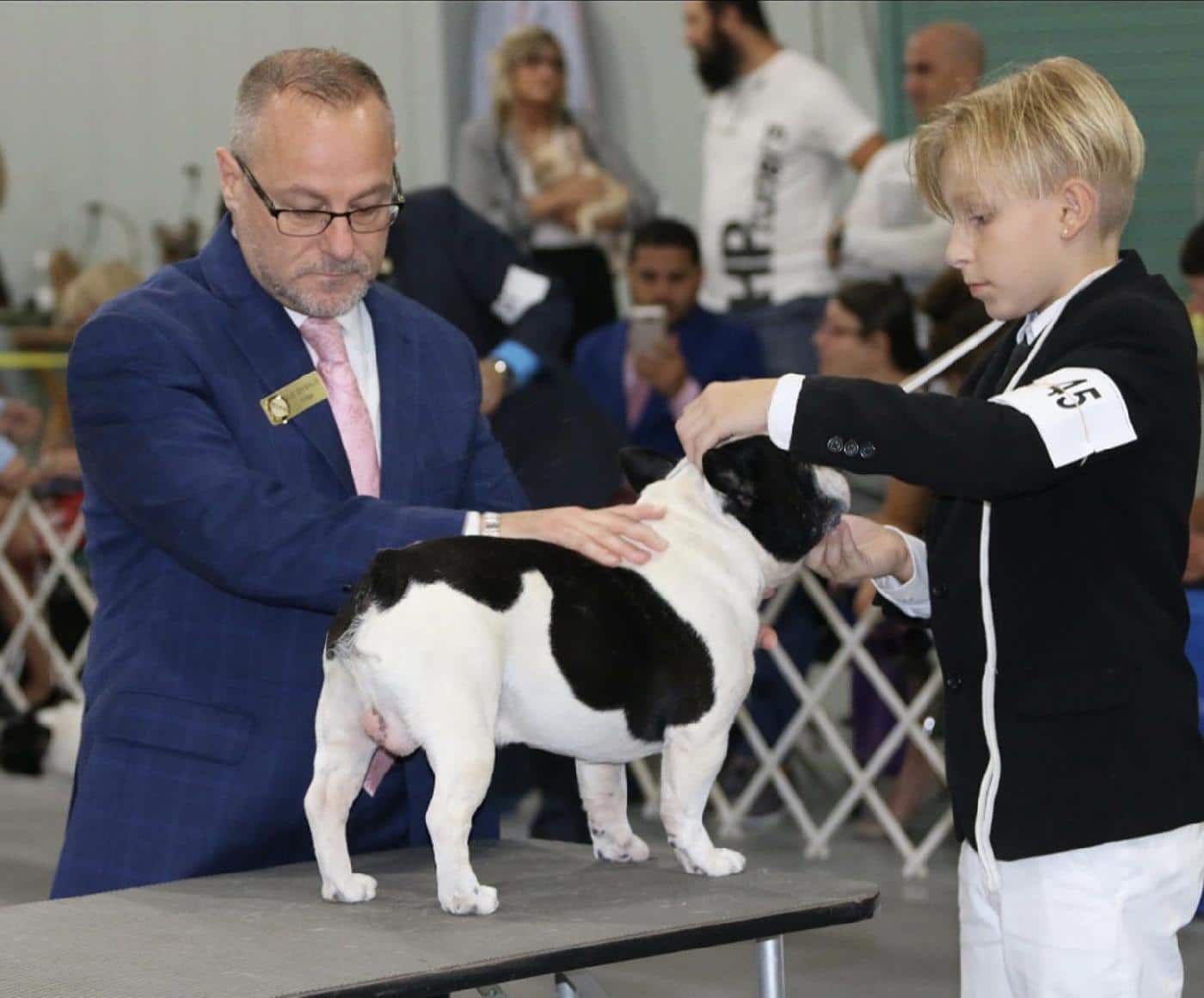
Home » French Bulldog: You’re Gonna Be Popular!

Picture Westminster 1896, the first year that the French Bulldog was exhibited at this show. The breed was such a hit that it was featured on the cover of the Westminster catalog the following year. At this debut show, French Bulldogs with both bat ears and rose ears were shown. The judge from England only awarded dogs with rose ears as those were the preference in Europe at the time.
The American exhibitors were infuriated and, shortly thereafter, formed the French Bull Dog Club of America which resulted in the original standard with bat ears as the only permissible ear. In my opinion, if the club was formed as a result of the shape and carriage of an ear then it is reasonable to assume that this is a very important hallmark of the French Bulldog breed.
This article will go deeper into the hallmarks of this special breed, but first it is necessary to understand why this breed has become the AKC’s fourth most popular breed.
The French Bulldog, or “Frenchie” as they are affectionally called, is an active, intelligent, muscular dog of heavy bone and smooth coat. The breed is compactly built, meaning closely and neatly packed together or dense and of medium or small structure. Simply put, this is a big dog in a medium-to-small, compact body.
The charm of Frenchies lies in their temperament, which can range from a total clown and goofball to stubborn and headstrong. The antics of this breed can have owners laughing all day or feeling frustrated due to their mischievous pranks and misdeeds, topped off with daily doses of “zoomies.” Then when you least expect it, they become loving snoozing lapdogs that will melt the heart of even the most cold-hearted person. Once you have been smitten and fallen in love with one, having a Frenchie is like eating potato chips… you can’t have just one!
Now, let’s factor in the hallmarks of the breed. The French Bulldog has a square head. It is not just square; it is large and square. When looking at the head you can see a square created by the top of the skull, which is flat, down to the muscles of the cheeks, which are well-developed, to a broad muzzle that finishes with an underjaw that is deep, square (here we go again with square), broad (just mentioned that twice), undershot, and well turned up.
It is important to note that undershot and well turned up are not synonymous with a reverse scissors bite. Wry mouths and any bites other than undershot are serious faults. When exhibitors show judges the bite, it is essential that judges see a bite that is correct for the breed.
While we continue to talk about the head, we cannot ignore those ears. As previously stated, the ears are important and are what got the French Bulldog’s American story started. Bat ears are broad at the base, elongated, with round top, set high on the head but not too close together, and carried erect with the orifice to the front. Elongated generally suggests that something is unusually long in relation to the width. Please look for those beautiful ears when the dog is alert and on the ground. Can the ears be too big? Sure, balance is important. However, the bigger problem is small ears that some refer to as teddy bear ears or dorito chips. The ears must be large enough to balance the large square head described earlier.
The final hallmark is the roach back, which per the breed standard is further described as having a slight fall close behind the shoulders, gradually rising to the loin which is higher than the shoulder, and rounding at the croup. The important parts of that description are the words gradually and rising to the loin. Not before, not after, but rising to the loin is key. Rounding at the croup with a short, hung low, thick root and fine tip tail carried low in repose finishes a beautiful topline.
As a judge, once the dogs with the strongest type have been identified, there is an additional element that should always be considered. This would be movement. Anyone can hand stack a dog on the ground or on the table to deliver a nice overall picture. Shortcomings and faults will be revealed when gaiting. The French Bulldog should four-track with the front tracking wider than the rear because the dog is broader at the shoulders and is tapering toward the rear. The dog should have reach and drive and be unrestrained, free, and vigorous while holding the hallmark topline described as a roach back. A dog should be sound, both in type and in movement.
All of this must be accomplished while not exceeding 28 pounds. When in question, we ask that judges call for scales. Dogs over 28 pounds would be disqualified (DQ) from competition. For the record, all points of the breed are well distributed and bear good relation one to the other. The dog should never appear poorly proportioned. A bitch is described the same as a dog. However, we do not expect her to bear characteristics to the same degree.
In the ring, a judge hopes to find and reward a muscular dog of heavy bone, with a large square head, bat ears and carrying a roach back while moving with reach and drive. What happens when you do not have all of it on one dog? The first step would be not to judge one part of the dog. Look for the most balanced dog and the one closest to the dog the standard describes. As a breeder, I ask myself, which dog would I choose first to be part of a breeding program because it possesses the most compelling breed type?
Now that we have an image of this charming dog with clownlike behavior, the elephant in the room needs to be addressed. Resulting from the popularity and charm of this breed as well as the price point, an inevitable problem has evolved that needs to be faced and overcome: people have become attracted to breeding them for the wrong reasons.
Registrations of French Bulldogs have increased from 1,513 in 2000, to 7,145 in 2010, and 41,042 in 2019. These increases are not representative of preservation breeders, but rather those looking to sell these popular dogs with little regard to anything other than financial gain. Shortcuts are taken in order to turn a higher profit without health testing, and with no regard for the AKC standard.
Masses have taken to the breeding of DQ colors such as blue, blue fawn, liver, lilac, platinum, blue & tan and black & tan. We also see DQ patterns such as merle, and even long-coated and hairless Frenchies. These dogs are referred to as “rare” and are priced at exorbitant amounts. Not helping the situation, celebrities are purchasing and posting pictures with DQ colored or marked dogs on social media. We have great concern for the health and longevity of these dogs.
The Parent Club (FBDCA) is heavily focused on preserving, protecting, and promoting our beloved breed. Everyone must do their part to protect the purebred French Bulldog. The ongoing promotion of the overpriced fad colors, patterns or long coated dogs being called Frenchies needs to be stopped. These are not French Bulldogs and are not purebred.
Judges, when in question, pay close attention to the eye and nose color and refer to the color section of the French Bulldog AKC standard. Typically, a DQ colored dog will not have a black nose or a dark eye. The dog community should refer inquiries to French Bulldog breeders whom you know and trust are preserving the breed.
People looking for a French Bulldog can also be sent to the French Bull Dog Club of America website where a breeder referral page exists, giving puppy buyers the ability to connect with preservation breeders. In addition, the FBDCA monitors the AKC marketplace for color breeders and other non-members claiming to be club members in order to gain preferential placement on the list of ads.
These little clowns will see much brighter days with ongoing education and exposure of the public to correctly bred dogs. With each person that is steered away from non-preservation breeders, progress is made. We should be able to proudly say French Bulldogs are the fourth most popular AKC breed because we have the best interest of our potato chips in mind, meaning our beloved dogs.
French Bulldog: You’re Gonna Be Popular! – Showsight Magazine September 2020 Issue
Showsight Magazine is the only publication to offer dedicated Digital Breed Magazines for ALL recognized AKC Breeds.
Read and learn more about the adaptable French Bulldog dog breed with articles and information in our French Bulldog Dog Breed Magazine.
Error embedding FlippingBook shortcode, please check the flipbook url. (https://digital.showsightmagazine.com/view/931293/)